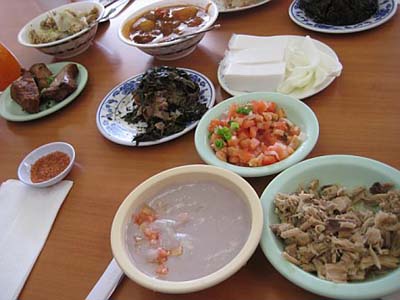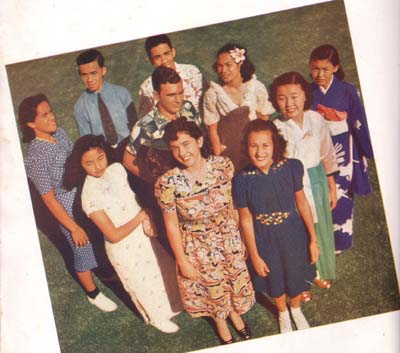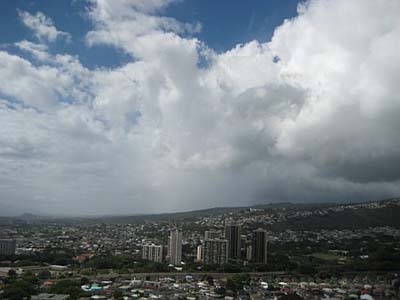24 Sep Hawaiian Eye – Pt. 5 (A day with Regine)
 Hawaiian specialites at Helena’s: (from foregournd, left to right) poi, kahlua pork, a bit of Hawaiian seasoned salt, lau lau, lomi salmon, fried ahi tuna, haupia (with sliced onion, which we ate with the salt), tofu, beef stew and more lau lau. Hawaiian specialites at Helena’s: (from foregournd, left to right) poi, kahlua pork, a bit of Hawaiian seasoned salt, lau lau, lomi salmon, fried ahi tuna, haupia (with sliced onion, which we ate with the salt), tofu, beef stew and more lau lau. |
Tuesday, Sept. 18
We spent the day with Regine, Laura’s twin sister, and the evening with Laura and John. She lives just a few minutes away in the older section of Mililani, land of rusty dirt. She came to pick us up but we headed straight back to her house because I needed her son William, an extremely tall (for someone who’s 3/4-Asian) handsome lad who speaks flawless Japanese and is some sort of young genius studying Japanese and poli-sci in college, to scan a few pages out of an old yearbook for me.
The yearbook is for McKinley High School, the imposing campus right in downtown Honolulu, not far from the state capitol and royal palace grounds. It’s the school my oldest aunt attended, and so did some of the Hanzawa family members. Auntie Harriet had borrowed the McKinley yearbook for 1939 from a friend of hers who remembered my Aunt Miki, the one everyone says was “the smart one,” and the one who would have attended the University of Hawaii if my grandfather hadn’t taken the entire family back to Japan.
Miki, or Michiko, shows up on a list of students who were inducted into the National Honor Society. The page with her senior portrait lists her accomplishments:
“Asakawa, Michiko – McKinley Government Magazine & Map Chairman; National Honor Society; Torch Society.”
 My Aunt Miki Asakawa, wearing the blue kimono, from the 1939 yearbook for McKinley High School. She was a member of the National Honor Society and had been accepted to attend the University of Hawaii when my grandfather decided to move the family back to Japan in 1940. My Aunt Miki Asakawa, wearing the blue kimono, from the 1939 yearbook for McKinley High School. She was a member of the National Honor Society and had been accepted to attend the University of Hawaii when my grandfather decided to move the family back to Japan in 1940. |
On a page just inside the front cover, a color photo shows a group of students – representative of the student body’s diverse ethnic mix, I assume – including Miki, wearing a beautiful dark-blue kimono. She looks serious and intense, but somehow still playful. I felt good knowing she was a leader within her school.
Once I scanned the yearbook, Regine took us to lunch. We requested local food, so she suggested Helena’s, which she knew about but had never visited. We were on the H-1 when she suggested Helena’s and she made a couple of calls to see if she could find the address. Meanwhile, I used my Treo and found it by Googling the name. I found the address just in time for her to take the next exit off the highway. Gotta love the Internet.
Helena’s is a haunt for locals and regulars – so much so that when we walked in, everyone in the small room stopped talking to look us over. Once looked-over, the conversations resumed. There were business folks on lunch break, neighborhood types and haoles and Hawaiians alike.
It’s a dive restaurant where you order at a small counter and dine at one of a handful of tables. The sign outside is so faded that you can hardly read it, but it doesn’t matter — you can tell people flock here for their “Plate Lunch” meals, the ubiquitous Hawaiian combination dishes.
The food was wonderful – lau lau, poke, lomi salmon, beef stew (a favorite of Erin, in a rich tomatoey broth), ribs, teriyaki beef, and a special, deep-fried ahi, were served up in a jiffy. The ahi was super delicious. The woman at the register (whom I assumed to be an owner or a family member) said she likes it so much she cooks her ahi at home the same way. When we asked bout the breading, she surprised us by saying there was no breading. She simply put rock salt on the fish and let it melt and soak in, then the ahi was fried quickly in very hot oil. No other flavorings, no breading.
After lunch, Regine drove us on some back streets uphill and past a famous old teahouse that’s now used for events, and past homes and neighborhoods where family members lived or still live, before taking us downtown to the Health Department. We wanted to see if we could get copies of both the marriage certificate for my grandparents, and the death certificate for my grandmother.
We struck out, unfortunately.
For the marriage certificate, it would help if we had at least a specific year, but we could only guess at a range – say, 1917 to 1920 or so. That’s because we knew my Aunt Miki was the oldest girl in the family, and she graduated from McKinley High School in 1940. There was an older brother, the one who went into the Army before the family moved. That meant my grandparents had been married at least about 20 years, and probably not too much longer than that. That put their marriage around 1917-’20.
The clerk at the Health Department said without a specific year – and even an exact date – it would take some time and effort to look up the certificate because they have to be researched manually in books. So we told her we’d wait on the marriage document.
The death certificate was even more difficult. The document could only be given to a blood relative who was either born or married in Hawaii. I qualified as a blood relative, but wasn’t born or married in Hawaii, so I wasn’t in the state’s database. My cousins on the Hanzawa side couldn’t request the death certificate without jumping through a series of hoops to prove their grandfather was a blood relative of my grandmother. I’ll have to ask either my cousin Keith, the son of my Uncle Alex, or perhaps my Aunt Agnes in Illinois or Aunt Adan in Michigan.
Regine offered to try requesting the document herself, but the records office closed at 3:30 – and it was now 3:35.
We didn’t dwell on the bureaucracy – obviously, the fates didn’t want me to find that information this day.
 View of Honolulu from Puncbowl National Cemetery. View of Honolulu from Puncbowl National Cemetery. |
So Regine took us sight-seeing, first at Punch Bowl, the national military cemetery where her and Laura’s father is interred in a niche (the gravesites are all filled). Then she drove us up Pali Highway to the Pali Lookout, where an ancient Hawaiian battle was waged (the losing soldiers were thrown off a scary cliff to their gruesome deaths). The most memorable characteristic of Pali Lookout is how windy it is.
It’s so windy I have to tighten my baseball cap to where it’s squeezing my head, just so it won’t blow off. I was taken to the Lookout on my last visit to Hawaii and it was still vivid in my memory – I wanted to make sure Erin experienced the place.
Regine also took us on the H-3 and pointed out noteworthy places all along our drive.
She took us back to Laura’s after a very nice road tour, and we went out to dinner at a Thai restaurant in the Aiea district. Dinner was great – John ordered for all of us. Marika went, and so did Jenny’s friend Clarise, whom we met the night before when we got home from our long night with the Aunties. And as a surprise, Jenny was waiting at the restaurant.
She’d planned a trip to San Diego but it fell through (she’s a pilot with Aloha, and so is Clarise). So it was great to be with everyone. Erin and I felt loved and appreciated and accepted the entire time we were at Laura and John’s house. We thanked them profusely and promised to come back. This was the last night we’d spend with them – but we’d return.



